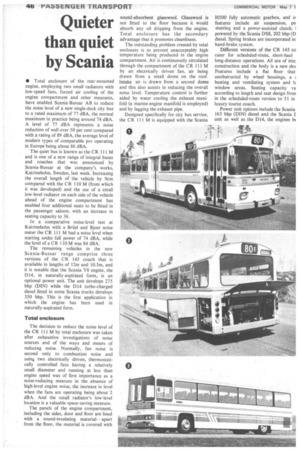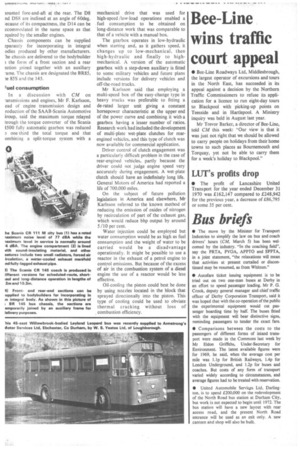• Quieter than quiet by Scania
Page 48

Page 49

If you've noticed an error in this article please click here to report it so we can fix it.
• Total enclosure of the rear-mounted engine, employing two small radiators with low-speed fans, forced air cooling of the engine compartment and other measures, have enabled Scania-Bussar AB to reduce The noise level of a new single-deck city bus to a rated maximum of 77 dBA, the normal maximum in practice being around 74 dBA. A level of 77 dBA represents a noise reduction of well over 50 per cent compared with a rating of 89 dBA, the average level of modern types of comparable psv operating in Europe being about 86 dBA.
The quiet bus is known as the CR 111 M and is one of a new range of integral buses and coaches that was announced by Scania-Bussar at the company's works, Katrineholm, Sweden, last week. Increasing the overall length of the vehicle by 9cm compared with the CR 110 M (from which it was developed) and the use of a small low-level radiator on each side of the vehicle ahead of the engine compartment has enabled four additional seats to be fitted in the passenger saloon, with an increase in seating capacity to 36.
In a comparative noise-level test at Katrineholm with a Briiel and Bjoer noise meter the CR 111 M had a noise level when starting under full power of 74 dBA, while The level of a CR 110 M was 84 dBA.
The remaining vehicles in the new Scania-Bussar range comprise three versions of the CR 145 coach that is available in lengths of 12m and 10.3m, and it is notable that the Scania V8 engine, the D14, in naturally-aspirated form, is an optional power unit. The unit develops 275 bhp (DIN) while the D14 turbo-charged diesel fitted in some Scania trucks develops 350 bhp. This is the first application in which the engine has been used in naturally-aspirated form.
Total enclosure The decision to reduce the noise level of the CR 111 M by total enclosure was taken after exhaustive investigations of noise sources and of the ways and means of reducing noise. Normally, fan noise is second only to combustion noise and using two electrically driven, thermostatically controlled fans having a relatively small diameter and running at less than engine speed was of first importance as a noise-reducing measure in the absence of high-level engine noise, the increase in level when the fans are operating being about 2 dBA. And the small radiator's low-level location is a valuable space-saving, measure.
The panels of the engine compartment, including the sides, door and floor are lined with a sound-insulating material—apart from the floor, the material is covered with sound-absorbent glasswool. Glasswool is not fitted to the floor because it would absorb any oil dripping from the engine. Total enclosure has the secondary advantage that it promotes cleanliness.
The outstanding problem created by total enclosure is to prevent unacceptably high temperature being produced in the engine compartment. Air is continuously circulated through the compartment of the CR Ill M by an electrically driven fan, air being drawn from a small dome on the roof. Intake air is drawn from a second dome and this also assists in reducing the overall noise level. Temperature control is further aided by water cooling the exhaust manifold (a marine-engine manifold is employed) and by lagging the exhaust pipe.
Designed specifically for city bus service, the CR 111 M is equipped with the Scania H500 fully automatic gearbox, and o features include air suspension, pa steering and a power-assisted clutch. I powered by the Scania DS8, 202 bhp (D diesel. Spring brakes are incorporated in hand-brake system.
Different versions of the CR 145 co cater for scheduled-route, short-haul long-distance operations. All are of inte construction and the body is a new des Features include a flat floor that unobstructed by wheel housings, a heating and ventilating system and h window areas. Seating capacity va according to length and seat design from in the scheduled-route version to 51 in luxury tourist coach.
Power unit options include the Scania 163 bhp (DIN) diesel and the Scania I unit as well as the D14, the engines tx lounted fore-and-aft at the rear. The D8 nd DS8 are inclined at an angle of 60deg. lecause of its compactness, the D14 can be ecomrnodated in the same space as that equired by the smaller engines.
Chassis components can be supplied eparately for incorporating in integral odies produced by other manufacturers. 'he chassis are delivered to the bodybuilder .1 the form of a front section and a rear ection joined together with an auxiliary -arm. The chassis are designated the BASS, le 85S and the 145.
'uel consumption
In a discussion with CM on -ansmissions and engines, Mr F. Karlsson, cad of engine transmission design and .roduction of the SAAB-Scania Automotive iroup, said the maximum torque relayed [trough the torque converter of the Scania 1500 fully automatic gearbox was reduced D one-third the total torque and that ombining a split-torque system with a
mechanical drive that was used for high-speed /low-load operations enabled a fuel consumption to be obtained on long-distance work that was comparable to that of a vehicle with a manual box.
The gearbox operates in low-hydraulic when starting and, as it gathers speed. it changes up to low-mechanical, then high-hydraulic and finally to highmechanical, A version of the automatic gearbox with a step-down auxiliary is fitted to some military vehicles and future plans include versions for delivery vehicles and off-the-road trucks.
Mr Karlsson said that employing a multi-speed box of the easy-change type in heavy trucks was preferable to fitting a de-rated larger unit giving a constant horsepower characteristic at the upper end of the power curve and combining it with a gearbox having a lesser number of ratios. Research work had included the development of multi-plate wet-plate clutches for rearengined vehicles, and this type of clutch was now available for commercial application.
Driver control of clutch engagement was a particularly difficult problem in the case of rear-encined vehicles, partly because the driver could not judge engine speed very accurately during engagement. A wet-plate clutch should have an indefinitely long life. General MOtors of America had reported a life of 700,000 miles.
On the subject of future pollution legislation in America and elsewhere, Mr Kant son referred to the known method of reducing the emission of oxides of nitrogen by recirculation of part of the exhaust gas, which would reduce bhp output by around 5/10 per cent.
Water injection could be employed but water consumption would be as high as fuel consumption and the weight of water to be carried would be a disadvantage operationally. It might be possible to use a reactor in the exhaust of a petrol engine to control emissions. But because of the excess of air in the combustion system of a diesel engine the use of a reactor would be less effective.
Oil-cooling the piston could best be done by using nozzles located in the block that sprayed directionally into the piston. This type of cooling could be used to obviate thermal cracking without loss of combustion efficiency.










































































































































































































